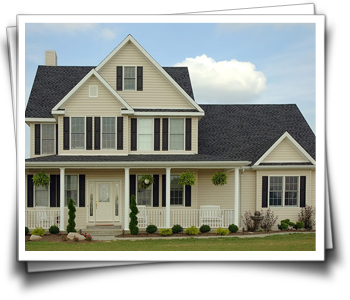Siding
 Siding is the most visible portion of your home, and is what most people see when they walk or drive past. Not only is it a decorative exterior covering, it also serves as the primary barrier between your home and nature’s damaging elements.
Siding is the most visible portion of your home, and is what most people see when they walk or drive past. Not only is it a decorative exterior covering, it also serves as the primary barrier between your home and nature’s damaging elements.
If your existing siding is improperly installed, lacks proper flashing, or is showing its age in the form of cracks and rot, it may be allowing water to penetrate into your home’s wooden structure causing mildew, mold, and/or rot. If you find these problems, it may be time to consider replacing your old siding with a new and improved, more weather-resistant product.
Installing new siding can dramatically increase the value of your home, not only because it transforms the exterior, but also because new siding that is properly installed protects your home for many years to come. There are several kinds of siding you can choose from.
Natural Wood
Nothing provides the architectural warmth and beauty as natural wood siding. Although available in several different species of wood (such as redwood and cypress), the most readily available and reasonably priced wood siding is cedar. If you are considering installing cedar siding on your home, consider the advantages and disadvantages. Cedar is very durable, and has been used for hundreds of years because of its resistance to rot and insects.
Also, due to modern sustainable forestry techniques, cedar is considered a renewable resource and is biodegradable at the end of its useful life. A clear disadvantage to using cedar is that it requires maintenance periodically; you’ll have to stain or paint it every 5 to 7 years or it will quickly warp and crack beyond repair. Another drawback is that it’s extremely flammable, so check with your insurance company to see if you’ll pay more insurance for having cedar on your home.
Vinyl siding
Drive through most housing developments today, and you’ll notice that they are using vinyl siding on the exterior of the houses. Vinyl siding has become increasingly popular in recent years due to its maintenance free qualities. Unlike wood siding that requires painting or staining every 4-6 years, vinyl siding only requires periodic washing with a mild solution of bleach and water. Another advantage to vinyl siding is that the color is manufactured directly into the vinyl which will last much longer than paint.
However, this can be a disadvantage as you cannot readily change the color of your home’s siding if you find it unattractive. Another disadvantage to vinyl is that it fades. Look behind the end laps of vinyl siding that is 10-15 years old, and you’ll see a significant difference between the concealed vinyl and that exposed to the sun. Also, vinyl siding is very thin and, if not properly installed, will easily blow off in strong winds, leaving your house exposed to the elements. Lastly, old vinyl siding is very brittle and will have a tendency to crack and even break if anything hits it.
Fibrous cement siding
A relative newcomer to the building industry (compared to wood), Fibrous-Cement siding has gained significant popularity as a replacement for natural or engineered wood siding. As its name implies, it is fabricated out of Portland cement, sand, and cellulose fiber, which produces an unusually strong and durable product. In coastal regions, or areas that have consistently high humidity levels, fibrous cement siding is a natural choice. It is much heavier than wood or vinyl siding however, and subsequently more difficult and expensive to install. An additional drawback is that it requires painting and an occasional washing.
However, where cedar siding may require staining every 4-6 years, paint that has been properly applied to fibrous cement siding will easily last 7-10 years. In fact, the top manufacturers of fibrous cement siding offer a pre-painted product with a 15 year warranty on the factory applied paint. There are also many finish options available with fibrous cement siding, such as smooth, beaded, or a wood-grain look. Because the composition is mainly cement and sand, manufacturers guarantee this siding for 50 years against rotting, splitting, warping, buckling, or swelling. It is also resistant to rain, hail, snow, salt air, and termite/insect damage. Lastly, unlike wood or even vinyl siding, it is noncombustible.
How to Install Siding
The first decision of a siding project is to determine if you just need to repair and paint your siding, remove and replace your siding completely, or in some cases you can go over the top with another layer of siding. Once you have decided upon the manner of installation, you can come up with a budget and pick the type of siding product for your home.
When installing siding on your home, it is important to be aware that siding projects may appear simple initially, but are usually much more complex. For example, it is imperative to properly install flashing behind any potential water entry points, such as siding joints, at inside and outside corners, around windows and doors, etc.
Many DIY’ers, and even some contractors overlook this extremely important aspect of siding installation and regrettably discover rotted walls years later as a result. Additionally, to end up with a professional looking siding job, it is important to consistently keep the siding accurately lined up, plumb and level. This is especially complex when going around windows, doorways, and corners. Another complex aspect of installing your siding, is accurately installing the exterior trim. Even the smallest mistake can make a huge impact when the project is completed; even if only one small part is not lined up correctly it impacts the entire project.
Installing Siding Professionally
Using a professional siding installer or contractor is the most cost effective option because they can work with you to determine the type of siding that is best for your home, what will work within your budget, and fits the needs of your residence. They also have access to the best prices on products, have access to the manpower to get your siding installed quickly and accurately, and already have the experience and tools to perform the installation correctly.
A contractor will make sure that siding is installed quickly and efficiently. They save time and material by having the necessary knowledge and experience needed to avoid waste due to mistakes or incorrect measurements. Also, because the exterior of your home is important to the value and perception of your home, it is important that it is installed correctly without unsightly mistakes.
A contractor will help organize and lead the specific craftsmen you will need to install the siding. Additionally, he/she can suggest cost saving ideas that can be done while the siding is being installed. For example, if you are replacing your siding, it is an ideal time to consider replacing the old, drafty windows in your house. It’s also a great time to install custom fabricated waterproof pans beneath your exterior doors to prevent water from rotting your floor.
Also, if you encounter rot while replacing the old siding on your house, a contractor will have the experience, man-power, and knowledge to make the proper repairs and keep the job moving forward. If you are using a professional contractor they will be able to organize any other craftsmen needed in a timely fashion, so there are no time lags or products wasted.
Here in Albemarle, Augusta, and Nelson Counties, there is a construction company you can trust to replace your siding, add siding to a new home construction or for any of your building needs. Contact Hatter and Sons, Incorporated for the best in carpentry, building techniques and leadership. Call Philip @ (540) 569-6351 today for a consultation.


